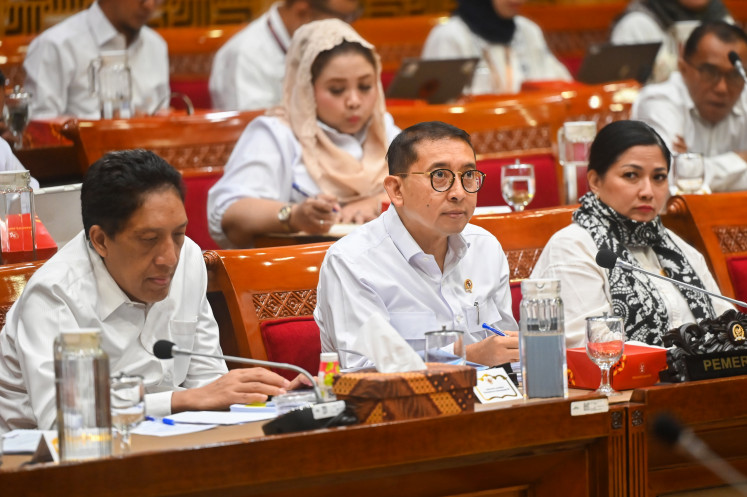Popular Reads
Top Results
Can't find what you're looking for?
View all search resultsPopular Reads
Top Results
Can't find what you're looking for?
View all search resultsNantu’s forest facing endless threats
Muddy: A male babi rusa in the wallow at Nantu, a site for the protected animals to congregate and consume salt and minerals
Change text size
Gift Premium Articles
to Anyone
M
span class="caption" style="width: 398px;">Muddy: A male babi rusa in the wallow at Nantu, a site for the protected animals to congregate and consume salt and minerals.It’s always lively and noisy in the forest of Nantu in the morning, with birds singing, macaques shrieking and jumping, and allo or white-tailed hornbills occasionally flapping their wings vigorously.
On the forest floor are creeping and interwoven green rattan stems the size of adult human wrists, with their young shoots partly buried before winding up and around towering trees. The sky is obscured, covered by the dense jungle.
Nantu is a wildlife reserve in a 31,215-hectare area on the banks of the Paguyaman-Boliyohuto River in Gorontalo.
The forest can be reached by land via Saritani hamlet in Wonosari, Boalemo regency, where one has to cross the Nantu River in thigh-high water.
Nantu is also accessible by sailing along the Paguyaman River from Mohiolo village in Asparaga, Gorontalo regency. Both routes take four to five hours from the capital of Gorontalo.
Nantu is an ecological witness to what English naturalist Alfred Russel Wallace described as an imaginary line separating Indonesia’s western and central zones, where the fauna of Asia and Australasia mixed to turn out animals only found in certain areas. Sulawesi is located in the Wallace Line region, and boasts numerous species of rare wildlife.
The wildlife reserve is home to diverse endemic mammals including the anoa or dwarf buffalo (Bubbalus depresicornis), the small primates called tarsiers (Tarsius Spectrum), and 35 endemic birds. Babi rusa or deer hogs (Babyrousa babyrussa), with their unique curved, upturned tusks, are one of the icons of Nantu’s forest.
Babi rusa can be seen in an open wallow 15 minutes’ walk from the reserve’s station and owned by Yayasan Adudu Nantu Internasional (YANI), an environmental foundation set up in 1990 by Lynn Marion Clayton, 47, a conservation biologist and babi rusa researcher.
YANI also cooperates with the Research and Technology Ministry, the Biology Research Center of the Indonesian Institute of Sciences (LIPI) and the Natural Resources Conservation Center (BKSDA).
The babi rusa wallow is called Kubangan Adudu, and is where five to six of the endemic wild hogs “hang out” in the morning and afternoon, chewing clay mud and sipping its water.
Clayton dubs the 20 x 60 meter wallow a “healthy café” because its groundwater contains salt and minerals, functioning to neutralize the poison in pangi fruits (Pangium edule), part of the natural diet of babi rusa.
“The hogs neutralize the pangi poison by sipping the mineral water in the wallow,” Clayton said.
Two observation huts are available for picture-taking or just to watch the rare sight of wallowing hogs. But patience is required for the babi rusa to make their appearance, and one should not make a lot of noise as the animals are very sensitive and apt to hide in the jungle.
During one visit, it took almost two hours to catch them at their “healthy café”.
It is easy to distinguish the sex of babi rusa. Males are bigger and have two curved tusks near the nose turning up to the area near the eyes, with two other fangs coming out from the mouth as the main weapon. Females mostly have no upper tusks. Both sexes are whitish gray.
According to Clayton, Adudu is the only wallow with mineral water in the wildlife reserve. Formerly, there were three other similar wallows in separate places: Nooti, Moliulo and Abati.
The three have now been leveled by forest squatters and local migrants for settlements.
Kubangan Adudu is unique because it is the only babi rusa wallow in Sulawesi and it is in Nantu. “In the other Sulawesi forests, the hogs neutralize the poison in their bodies by sipping warm geothermal water, also with high minerals,” said the woman who has studied the animals’ behavior for over 20 years.
Worn down: A fallen tree on the Nantu River encapsulates the environmental issues in the area, where encroachment and mining are causing erosion along several rivers.Although a paradise of flora and fauna, the ecosystem of Nantu is threatened by babi rusa hunting. Clayton said besides Nantu, mutilated babi rusa could easily be found in Langowan market in Minahasa, North Sulawesi, some 500 kilometers north of Gorontalo. Five hogs are sold on average every week at the traditional market, with sales increasing in number around Christmas and New Year’s.
In 2011, Clayton noted, 127 babi rusa were slaughtered and sold alongside vegetables in Langowan. In January 2012 YANI managed to release two babi rusa trapped in a dudeso, a rope snare set up by hunters.
The reproduction rate of babi rusa is very low, with only one to two being born every year. The population on the entire island of Sulawesi is estimated at just around 5,000, of which only 500 are left in Nantu.
The International Union for the Conservation of Nature (IUCN) — Convention on the International Trade of Endangered Species of Wild Fauna and Flora (CITES) declared the omnivore a protected rare species in 1996.
The other threat to babi rusa comes from wood and rattan looting. Nonfi Pandeirot, 49, a YANI activist, said such activity could be seen almost every day along the banks of the Paguyaman River, particularly since 2007. In August 2011, police on a monthly patrol in Nantu seized about 80 cubic meters of logs ready to be transported from the river.
Illegal gold mining operations from downstream areas to Nantu’s upper reaches by means of suction pumps pose yet another threat, this time of erosion, causing the collapse of dozens of large trees and muddying the Nantu River.
YANI assistant researcher Alfin Bawohan, 37, said the mining areas scattered in the Olongia, Nantu, Botuwonggubu and Botutumba rivers were predicted to damage the environment at a daily rate of 10 hectares.
Clayton put Nantu’s ecological destruction at 5 percent due to the spread of gold mining. “Nantu’s future remains threatened, nobody knows when it ends,” Clayton said.
— Photos by Syamsul Huda M. Suhari











